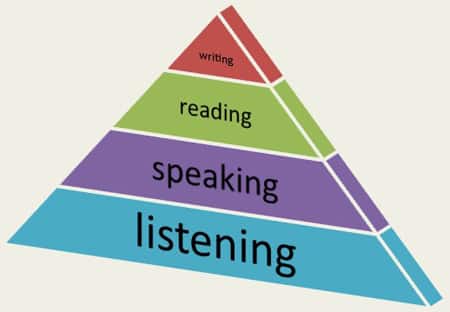Last Updated on June 25, 2021
A recent New York Times article, How to Get Your Mind to Read suggests that Americans are not good readers.
“Many of these poor readers can sound out words from print, so in that sense, they can read. Yet they are functionally illiterate — they comprehend very little of what they can sound out. So what does comprehension require? Broad vocabulary, obviously. Equally important, but more subtle, is the role played by factual knowledge.”
 How can we fix this problem of students who aren’t great readers? By teaching listening.
How can we fix this problem of students who aren’t great readers? By teaching listening.
When listening, students develop foundational language skills and learn the meanings of new words, which has been proven to increase reading comprehension. (Hogan, 2011; Cain & Oakhill, 2007). Whether the input is reading or listening, studies show that when students focus on meaning and semantic processes, the same areas of the brain are activated (Booth, 2002).
Building listening comprehension is the first step to developing a strong reading comprehension skill set. Students have greater understanding when they read about topics that are familiar. Listening can help students gain understanding in a wide variety of topics. Because audio allows students exposure to text that is above their independent reading level, it provides access to ideas and topics that may be out of reach by reading. Students can use audio increase their background knowledge and vocabulary understanding in many different topics, which will help them better comprehend what they are reading.
What is listening?
“Hearing is a sound; listening is a thought.”
This quote from Opitz and Zbaracki (2004) illustrates that listening is an active process that involves attention and thinking. An important goal for students is recognizing the difference and be able to differentiate when they are listening or merely hearing.
A more academic definition of listening is from the International Listening Association. They define listening as, “the process of receiving, constructing meaning from, and responding to spoken and/or nonverbal messages.”
Where do I start teaching listening?
In most schools, instruction in the skill of listening comprehension gets little attention. Now that state and national assessments are starting to include listening items, it’s important find ways to incorporate listening comprehension practice into lessons. The first thing to do is to remove barriers. The most frequently reported barriers among students according to a study by Golen (1990) are:
- listening primarily for details or facts;
- becoming distracted by noise;
- daydreaming or becoming preoccupied with something else while listening;
- detouring because of what the speaker has said;
- lack of interest in the speaker’s subject.
Next, follow the guidelines from a variety of research sources. Be sure the listening content is relevant and authentic with opportunities to develop both top-down and bottom-up processing. Listening strategies should be encouraged and activities should teach listening, not only test listening.
How do I start using Listenwise with students?
When you start using audio with students, think about stories that your students would appreciate. Teaching students how to recognize the power of language, appreciate oral interpretations, and understand the power of imagination are ways to help them become appreciative listeners. This is one of the levels of listening that you can develop in students. This appreciation for listening to stories might also translate to appreciation for reading stories, which can help develop a love of reading. You may want to start with stories that are not directly related to subject topics and develop appreciation for listening.
Here are a few suggestions for lessons using Listenwise audio.
Before listening, set a goal or purpose for listening. Are students listening to gain vocabulary, identify language features, understand the timing of events? Be sure to preview the vocabulary, build background, and set the stage for listening.
While listening, focus on understanding. Stop to check comprehension, take notes using listening organizers, or discuss opinions using classroom discussion questions. Research shows that during a lecture, taking a two-minute break and discussing the most important aspects of the lecture increases student comprehension (Hollingsworth, 1995).
After listening, reflect on new learning. The reflection should tie back to the purpose for listening, but students can also note new thoughts, what was interesting or surprising, or what they still have questions about. Listening multiple times for multiple purposes also increases student stamina and vocabulary learning.
Read about how other teachers are using Listenwise, and how audio can be used to teach content or meet language and listening goals.
